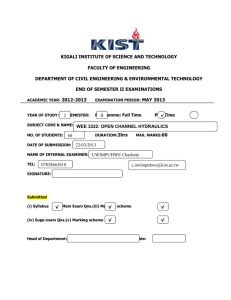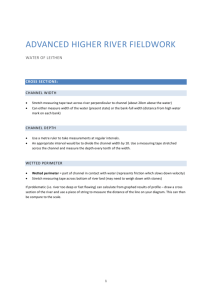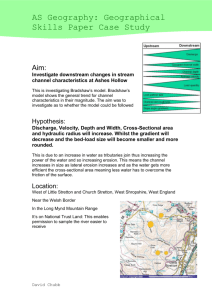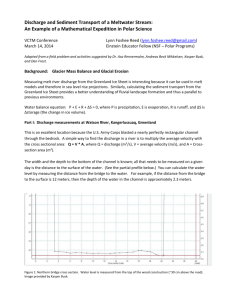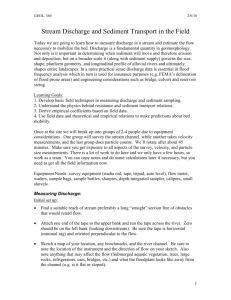Possible IGCSE River Fieldwork Topics and Procedures
advertisement
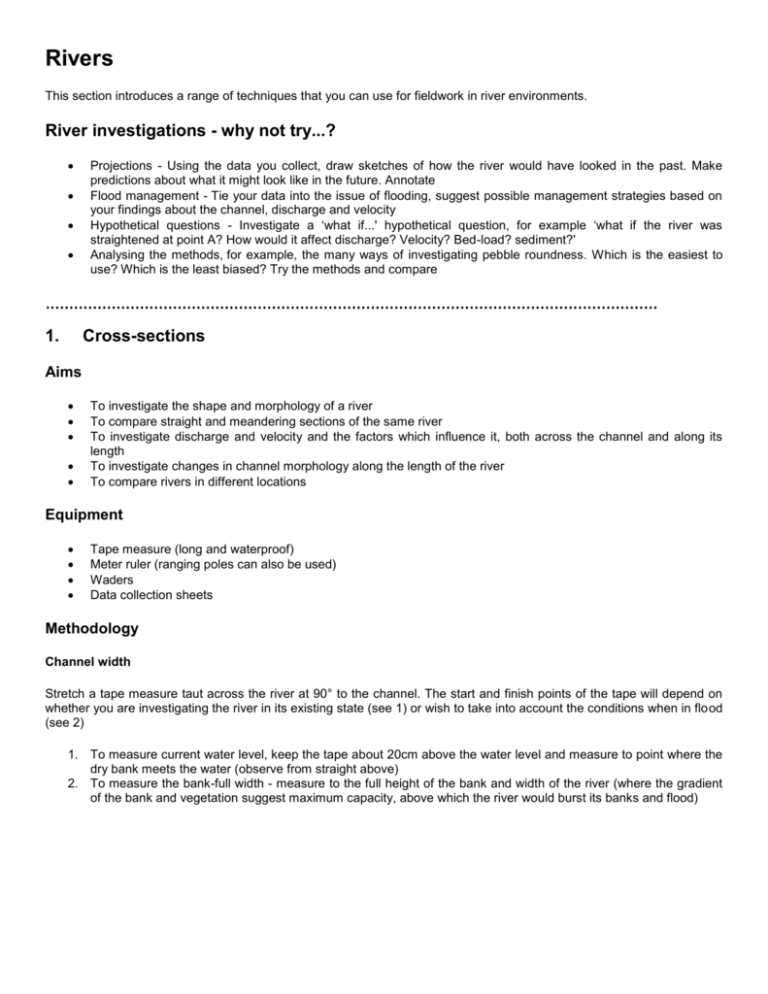
Rivers This section introduces a range of techniques that you can use for fieldwork in river environments. River investigations - why not try...? 1. Projections - Using the data you collect, draw sketches of how the river would have looked in the past. Make predictions about what it might look like in the future. Annotate Flood management - Tie your data into the issue of flooding, suggest possible management strategies based on your findings about the channel, discharge and velocity Hypothetical questions - Investigate a ‘what if...' hypothetical question, for example ‘what if the river was straightened at point A? How would it affect discharge? Velocity? Bed-load? sediment?' Analysing the methods, for example, the many ways of investigating pebble roundness. Which is the easiest to use? Which is the least biased? Try the methods and compare Cross-sections Aims To investigate the shape and morphology of a river To compare straight and meandering sections of the same river To investigate discharge and velocity and the factors which influence it, both across the channel and along its length To investigate changes in channel morphology along the length of the river To compare rivers in different locations Equipment Tape measure (long and waterproof) Meter ruler (ranging poles can also be used) Waders Data collection sheets Methodology Channel width Stretch a tape measure taut across the river at 90° to the channel. The start and finish points of the tape will depend on whether you are investigating the river in its existing state (see 1) or wish to take into account the conditions when in flood (see 2) 1. To measure current water level, keep the tape about 20cm above the water level and measure to point where the dry bank meets the water (observe from straight above) 2. To measure the bank-full width - measure to the full height of the bank and width of the river (where the gradient of the bank and vegetation suggest maximum capacity, above which the river would burst its banks and flood) Figure one: Measuring channel width. (Photo copyright Anne Vaughan). River depth Use a meter ruler or ranging pole and take measurements at regular 30cm to 50cm intervals (depending on the channel size). Figure two: Measuring river depth. (Photo copyright Amy Hatchwell). Wetted perimeter The wetted perimeter of a river refers to that part of the channel that is in contact with water. It represents the friction that slows down the river velocity, so the longer the wetted perimeter, the more friction between channel and water. Wetted perimeter can be measured using a heavy chain, rope or measure tape, which should be stretched across the river bed from one bank to the other. This can be hard to do, especially in larger channels or where the bed is very rough. Fast flowing water conditions can also be problematic. Wetted perimeter is often better calculated from the graphed results of the profile. Figure three: Measuring the wetted perimeter. (Photo copyright Anne Vaughan) Considerations and possible limitations A soft river bed can affect values. Ensure that the ruler just touches the bed A strong current or bow wave created by the ruler can give inaccurate depth readings. Ensure narrow edge faces upstream to reduce resistance Large boulders or debris, take care to record any anomalies in depth caused by irregularities in the river bed Using the data within an investigation Raw data can be used to draw a cross-section on graph paper (keeping the same scale for both axes if possible) Figure four: A river cross section shown in graphical format. Calculate the wetted perimeter (see method above) and cross-sectional area (width x depth, given in m2) of the river Channel efficiency can be calculated. This is the cross-sectional area divided by the wetted perimeter and gives an index value (no units) which gives an indication of the river's ability to maintain energy whilst transporting material. The higher the value, the more efficient the river. Differences downstream can be analysed Comparisons can be drawn between data collected a) from different sections of the same river, or b) from different rivers The gradient can be examined by conducting a long-profile down the length of the river. Ranging poles are positioned at equal distances upstream and downstream of the cross-section sites - these can be quite far apart while still being easily visible. Slope angle is found using a clinometers. Results can be related to information on velocity, bedload/sediment and efficiency to look for relationships Velocity Aims To investigate changes in the discharge of the river along its length To compare the discharge of rivers in different locations and environments To investigating patterns across a river channel or length To investigate how the human management of rivers can affect discharge and velocity Float method Equipment and methodology Floating object, for example an orange Tape measure and stop watch Record the time taken for the object to travel over a set distance. Considerations and possible limitations The float used must be visible, durable and not be affected by wind Be aware of possible user error meaning that the start or finish of the object placement is not exact. Throwing or pushing the object can affect results. Placing the object up-stream and having start and finish lines (tape measures) can help to minimise these errors This method only records surface velocity Repeated measurement and taking averages can reduce the margin of error Flow vanes or meters Equipment and methodology A flow meter or vane Tape measure across river (used for cross-section) Waders Record sheets Different models work differently and should come with instructions. All flow meters record the number of revolutions as water passes over the mechanism. Velocity should be recorded over a period of time, one minute for example, and repeated to obtain averages. Take recordings at different widths (horizontal) and depths (vertical) across the channel. Figure five: Using a flow meter to record the velocity of the river. (Image copyright Rebecca Stokes). Considerations and possible limitations The operator can affect readings. Stand beside or down-stream of the flowmeter Very fast or slow water can affect the accuracy of readings, take multiple readings and average results Using the data within an investigation Can be used in isolation or combined with other data, for example: River discharge can be calculated using cross-sectional area and average velocity as follows: o Discharge = cross-sectional area (m2) x velocity (m/s) = m3 / s. One river can be investigated or two or more compared Human influence on discharge can be investigated by also examining the catchment characteristics Sediment analysis Aims To investigate changes in the sediment and bed-load of a river along its length To compare sediment changes across the width of the river, particularly across meanders To compare the sediment load of rivers in different locations or environments To investigate the possible origins of sediment and bed-load in a river channel To relate river bed-load and sediment to past and current physical and environmental conditions Equipment Ruler or callipers Roundness or angularity charts/indexes (see below) Record sheet Figure six: Using callipers to measure river bedload. Methodology A popular technique is to use the ‘stations' for the depth readings across the channel as sample points for sediment analysis. 1. 2. 3. 4. Reach down with the index finger extended and select the first pebble it touches. Measure the length of the longest axis on this pebble Repeat this process, perhaps 10 times per location, ensuring that the distance from the bank is recorded Analyse your findings using a roundness index or chart Considerations and possible limitations Consideration needs to be given to the size of the sample and the method used to select pebbles in order to avoid bias The use of visual charts such as Power's can be subjective - one person's opinions on the roundness or angularity of a pebble may differ from another's Using the data within an investigation If using Cailleux, the roundness index for each location can be calculated by using the formula: R = 2r x 1000 / L where R = Cailleux roundness r = average radius of curvature (obtained from chart) L = average length of pebbles (in sample) Things to investigate Differences in the bed-load of a river as you move from source to mouth Differences across the channel itself could be analysed, for example across meanders The different bed-rock or parent material of catchments will affect the characteristics of river load, and could be compared Human interference or management of the river may also affect the river's ability to transport and erode material The size and sorting of material on river beaches and slip-off slopes can also be investigated, both down-beach and down-stream. Suspended load can be investigated by using two litre plastic drinks bottles. Insert a tube into the opening of each bottle and anchor at each site facing upstream (take care to stand downstream when setting up). Leave the bottle for a set period of time and collect. Leave it to stand for a few minutes and comment on sediment characteristics, for example colour, thickness of collected layer, water clarity, settling rate. The sediment can also be filtered and dried out to more accurately assess weights collected at different sites or under different conditions.

